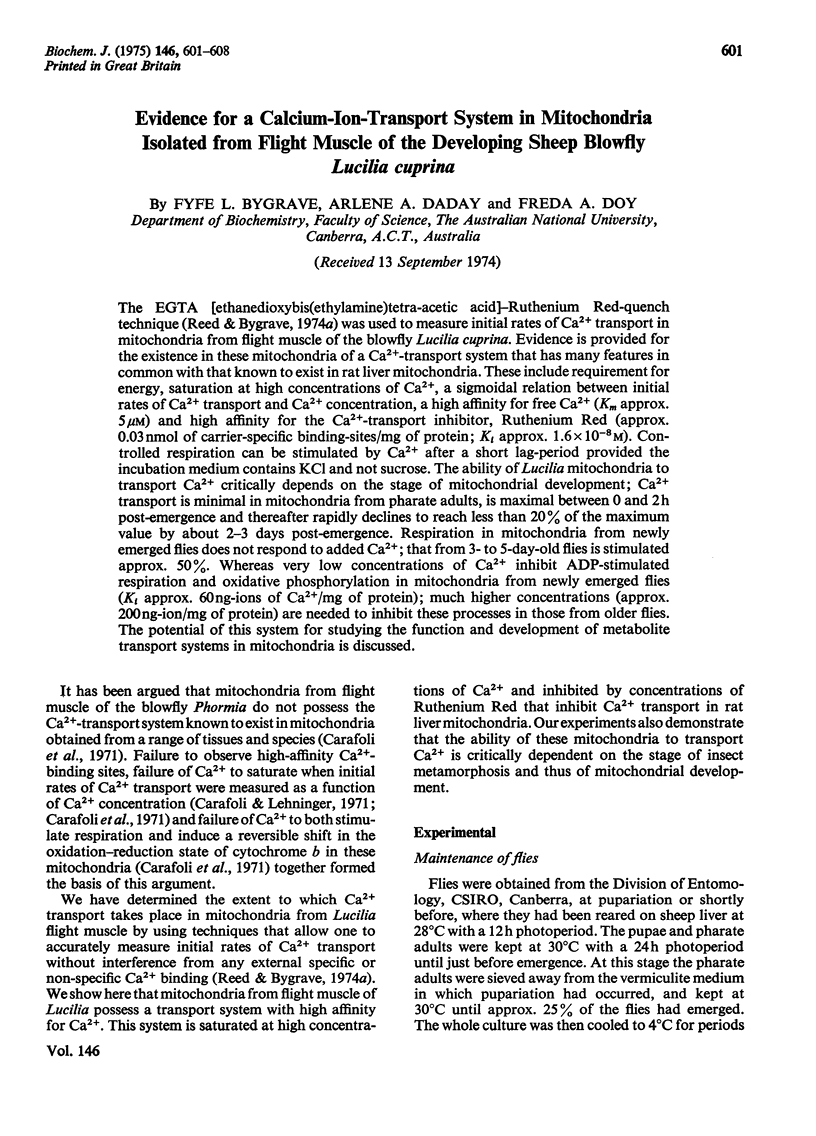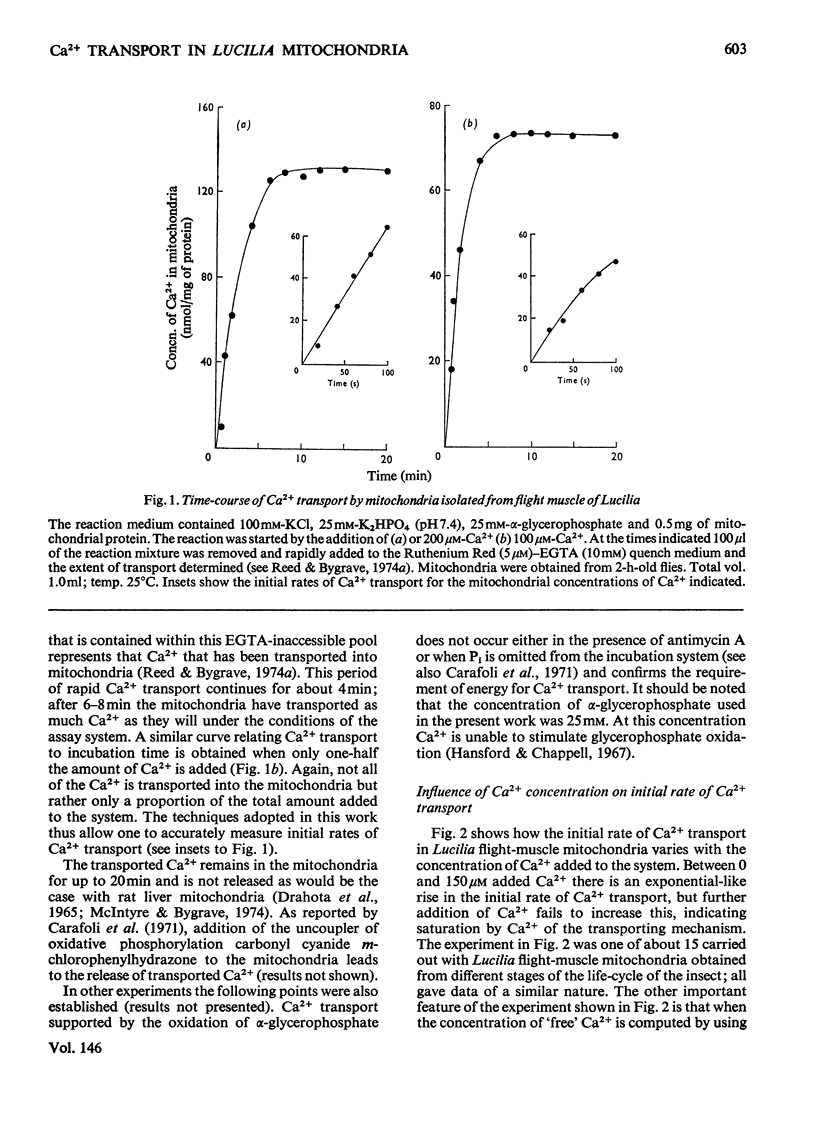Abstract
The EGTA (ethanedioxybis(ethylamine)tetra-acetic acid)-Ruthenium Red-quench technique (Reed & Bygrave, 1974a) was used to measure initial rates of Ca-2+ transport in mitochondria from flight muscle of the blowfly Lucilia cuprina. Evidence is provided for the existence in these mitochondria of a Ca-2+-transport system that has many features in common with that known to exist in rat liver mitochondria. These include requirement for energy, saturation at high concentrations of Ca-2+, a sigmoidal relation between initial rates of Ca-2+ transport and Ca-2+ concentration, a high affinity for free Ca-2+ (Km approx. 5 muM) and high affinity for the Ca-2+-transport inhibitoy, Ruthenium Red (approx. 0.03 nmol of carrier-specific binding-sites/mg of protein; Ki approx. 1.6 x 10- minus 8 M). Controlled respiration can be stimulated by Ca-2+ after a short lag-period provided the incubation medium contains KCl and not sucrose. The ability of Lucilia mitochondria to transport Ca-2+ critically depends on the stage of mitochondrial development; Ca-2+ transport is minimal in mitochondria from pharate adults, is maximal between 0 and 2h post-emergence and thereafter rapidly declines to reach less than 20% of the maximum value by about 2-3 days post-emergence. Respiration in mitochondria from newly emerged flies does not respond to added Ca-2+; that from 3-5-day-old flies is stimulated approx. 50%. Whereas very low concentrations of Ca-2+ inhibit ADP-stimulated respiration and oxidative phosphorylation in mitochondria from newly emerged flies (Ki approx. 60 ng-ions of Ca-2+/mg of protein); much higher concentrations (approx. 200 ng-ion/mg of protein) are needed to inhibit these processes in those from older flies. The potential of this system for studying the function and development of metabolite transport systems in mitochondria is discussed.
Full text
PDF







Selected References
These references are in PubMed. This may not be the complete list of references from this article.
- Akerman K. E., Saris N. E., Järvisalo J. O. Mitochondrial "high-affinity" binding sites for Ca2+ - fact or artefact? Biochem Biophys Res Commun. 1974 Jun 4;58(3):801–807. doi: 10.1016/s0006-291x(74)80488-2. [DOI] [PubMed] [Google Scholar]
- Bygrave F. L., Reed K. C. On the role of the adenosine diphosphate-adenosine triphosphate exchange reaction in oxidative phosphorylation: Effect of calcium. FEBS Lett. 1970 May 1;7(4):339–342. doi: 10.1016/0014-5793(70)80200-9. [DOI] [PubMed] [Google Scholar]
- Bygrave F. L., Reed K. C., Spencer T. Cooperative interactions in energy-dependent accumulation of Ca2+ by isolated rat liver mitochondria. Nat New Biol. 1971 Mar 17;230(11):89–89. doi: 10.1038/newbio230089a0. [DOI] [PubMed] [Google Scholar]
- Carafoli E., Hansford R. G., Sackton B., Lehninger A. L. Interaction of Ca2+ with blowfly flight muscle mitochondria. J Biol Chem. 1971 Feb 25;246(4):964–972. [PubMed] [Google Scholar]
- Carafoli E., Lehninger A. L. A survey of the interaction of calcium ions with mitochondria from different tissues and species. Biochem J. 1971 May;122(5):681–690. doi: 10.1042/bj1220681. [DOI] [PMC free article] [PubMed] [Google Scholar]
- DRAHOTA Z., CARAFOLI E., ROSSI C. S., GAMBLE R. L., LEHNINGER A. L. THE STEADY STATE MAINTENANCE OF ACCUMULATED CA++ IN RAT LIVER MITOCHONDRIA. J Biol Chem. 1965 Jun;240:2712–2720. [PubMed] [Google Scholar]
- Hansford R. G., Chappell J. B. The effect of Ca2+ on the oxidation of glycerol phosphate by blowfly flight-muscle mitochondria. Biochem Biophys Res Commun. 1967 Jun 23;27(6):686–692. doi: 10.1016/s0006-291x(67)80090-1. [DOI] [PubMed] [Google Scholar]
- Henderson P. J. A linear equation that describes the steady-state kinetics of enzymes and subcellular particles interacting with tightly bound inhibitors. Biochem J. 1972 Apr;127(2):321–333. doi: 10.1042/bj1270321. [DOI] [PMC free article] [PubMed] [Google Scholar]
- Luft J. H. Ruthenium red and violet. I. Chemistry, purification, methods of use for electron microscopy and mechanism of action. Anat Rec. 1971 Nov;171(3):347–368. doi: 10.1002/ar.1091710302. [DOI] [PubMed] [Google Scholar]
- Moore C. L. Specific inhibition of mitochondrial Ca++ transport by ruthenium red. Biochem Biophys Res Commun. 1971 Jan 22;42(2):298–305. doi: 10.1016/0006-291x(71)90102-1. [DOI] [PubMed] [Google Scholar]
- Morrison J. F. Kinetics of the reversible inhibition of enzyme-catalysed reactions by tight-binding inhibitors. Biochim Biophys Acta. 1969;185(2):269–286. doi: 10.1016/0005-2744(69)90420-3. [DOI] [PubMed] [Google Scholar]
- NIELSEN S. O., LEHNINGER A. L. Phosphorylation coupled to the oxidation of ferrocytochrome c. J Biol Chem. 1955 Aug;215(2):555–570. [PubMed] [Google Scholar]
- Reed K. C. An oxygen polarograph designed for undergraduate use. Anal Biochem. 1972 Nov;50(1):206–212. doi: 10.1016/0003-2697(72)90500-3. [DOI] [PubMed] [Google Scholar]
- Reed K. C., Bygrave F. L. A re-evaluation of energy-independent calcium-ion binding by rat liver mitochondria. Biochem J. 1974 Sep;142(3):555–566. doi: 10.1042/bj1420555. [DOI] [PMC free article] [PubMed] [Google Scholar]
- Reed K. C., Bygrave F. L. The inhibition of mitochondrial calcium transport by lanthanides and ruthenium red. Biochem J. 1974 May;140(2):143–155. doi: 10.1042/bj1400143. [DOI] [PMC free article] [PubMed] [Google Scholar]
- SZARKOWSKA L., KLINGENBERG M. ON THE ROLE OF UBIQUINONE IN MITOCHONDRIA. SPECTROPHOTOMETRIC AND CHEMICAL MEASUREMENTS OF ITS REDOX REACTIONS. Biochem Z. 1963;338:674–697. [PubMed] [Google Scholar]
- Southard J. H., Green D. E. High affinity binding of Ca++ in mitochondria: a reappraisal. Biochem Biophys Res Commun. 1974 Jul 10;59(1):30–37. doi: 10.1016/s0006-291x(74)80169-5. [DOI] [PubMed] [Google Scholar]
- Spencer T., Bygrave F. L. The role of mitochondria in modifying the cellular ionic environment: studies of the kinetic accumulation of calcium by rat liver mitochondria. J Bioenerg. 1973 Apr;4(3):347–362. doi: 10.1007/BF01648977. [DOI] [PubMed] [Google Scholar]
- Thorne R. F., Bygrave F. L. Calcium does not uncouple oxidative phosphorylation in tightly-coupled mitochondria from Ehrlich ascites tumour cells. Nature. 1974 Mar 22;248(446):348–351. doi: 10.1038/248348a0. [DOI] [PubMed] [Google Scholar]
- Vasington F. D., Gazzotti P., Tiozzo R., Carafoli E. The effect of ruthenium red on Ca 2+ transport and respiration in rat liver mitochondria. Biochim Biophys Acta. 1972 Jan 21;256(1):43–54. doi: 10.1016/0005-2728(72)90161-2. [DOI] [PubMed] [Google Scholar]
- Vinogradov A., Scarpa A. The initial velocities of calcium uptake by rat liver mitochondria. J Biol Chem. 1973 Aug 10;248(15):5527–5531. [PubMed] [Google Scholar]
- Walker A. C., Birt L. M. Development of respiratory activity and oxidative phosphorylation in flight muscle mitochondria of the blowfly, Lucilia cuprina. J Insect Physiol. 1969 Feb;15(2):305–317. doi: 10.1016/0022-1910(69)90277-7. [DOI] [PubMed] [Google Scholar]
- Wohlrab H. Respiration-linked calcium ion uptake by flight muscle mitochondria from the blowfly Sarcophaga bullata. Biochemistry. 1974 Sep 10;13(19):4014–4018. doi: 10.1021/bi00716a030. [DOI] [PubMed] [Google Scholar]


